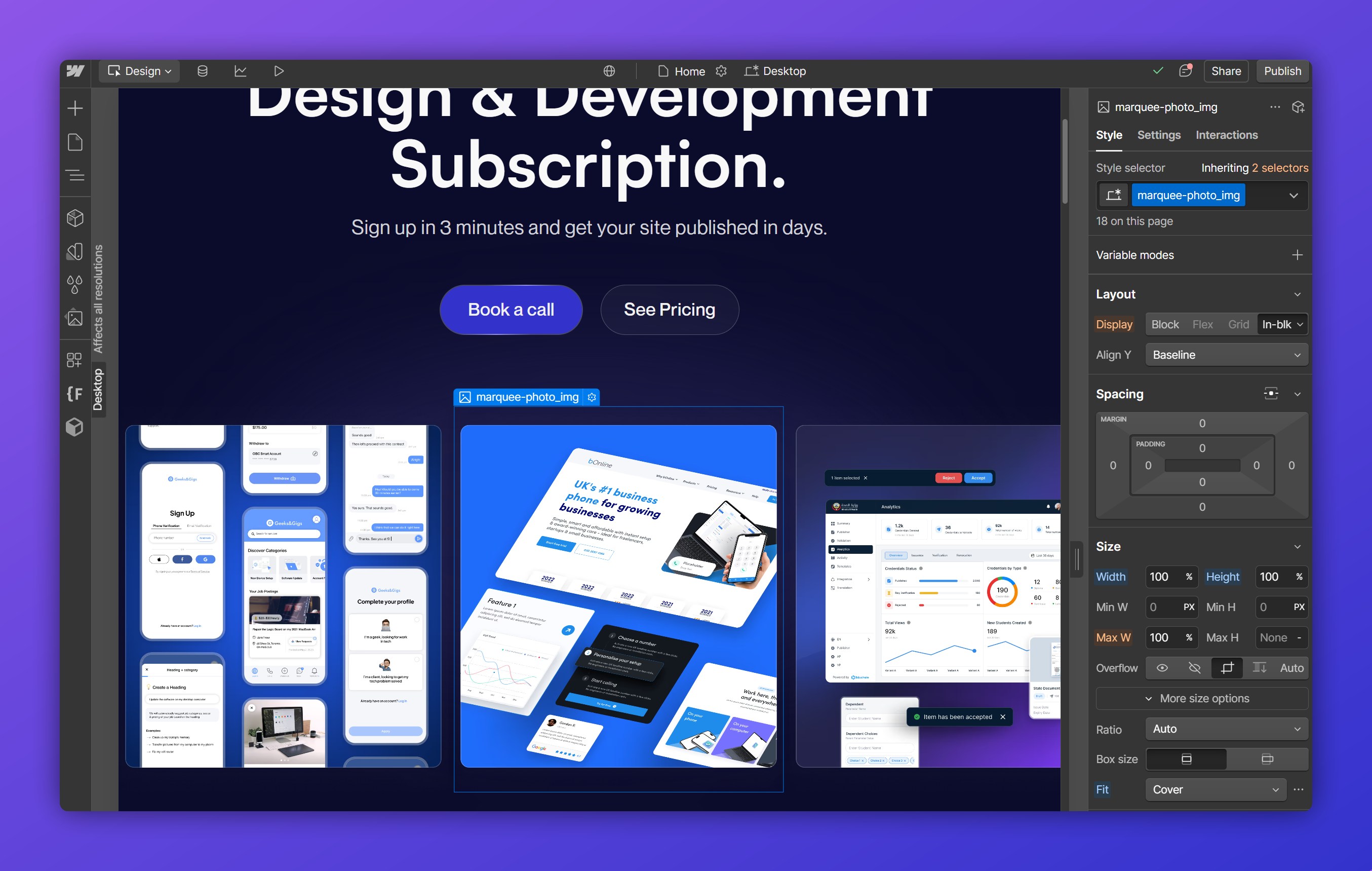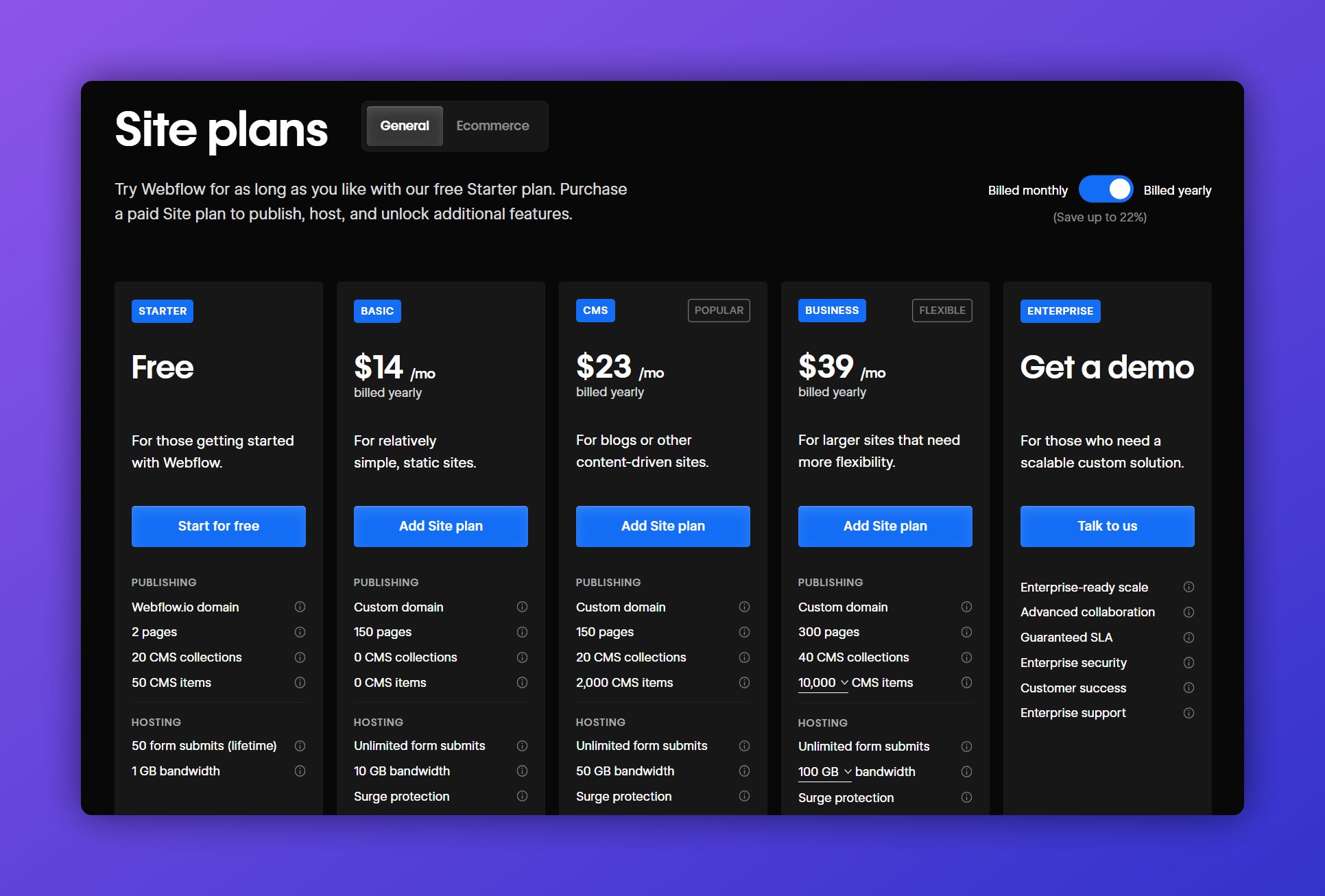TL;DR
Webflow and Divi are prominent website builders in 2025, each catering to different user needs.
Webflow offers advanced design flexibility with a visual editor, integrated CMS, and hosting services, making it ideal for designers and developers seeking high customization.
Divi, as a WordPress theme and page builder, provides an intuitive drag-and-drop interface with pre-made layouts, suitable for beginners and WordPress users looking for ease of use.
Your choice should align with your project's complexity, design requirements, and scalability needs.
Which one to choose… Divi or Webflow?
When it comes to website-building platforms in 2025, Webflow and Divi stand out as two of the most popular choices. These platforms cater to a wide range of users, from beginners to experienced developers, making the decision between them pivotal for the success of any web design or development project. In this article, we delve into the key features, strengths, and weaknesses of Webflow and Divi to help you make an informed choice.
By the way if you are considering between Divi and Webflow, be sure to also check our articles about: WordPress vs Webflow and Elementor vs Webflow.
Overview of Webflow

A Brief History
Webflow emerged in 2013 as a revolutionary tool aimed at bridging the gap between designers and developers. Over the years, it has evolved into a robust platform, offering advanced visual design capabilities, integrated CMS, and hosting services.
Primary Features
- Visual Editor: A powerful no-code interface enabling pixel-perfect designs.
- CMS Integration: Simplified content management for dynamic websites.
- E-commerce Functionalities: Built-in tools for creating scalable online stores.
- Hosting Services: Fully integrated, high-performance hosting options.
Target Audience
Webflow is tailored for professional designers and developers who value flexibility and precision in their work, making it an ideal choice for agencies and freelancers.
Overview of Divi

A Background on Divi
Launched in 2013 by Elegant Themes, Divi began as a WordPress theme and has grown into one of the most popular page builders in the WordPress ecosystem. Its versatility and user-friendly nature have solidified its place among WordPress enthusiasts.
Key Features
- Drag-and-Drop Builder: An intuitive interface for easy customization.
- Pre-Made Layouts: A library of templates for quick website setup.
- Plugin Integration: Seamless compatibility with a vast range of WordPress plugins.
Primary Users
Divi’s simplicity and flexibility make it a go-to solution for beginners, bloggers, and businesses already invested in WordPress.
Types of Websites: Which Platform Fits Best?
Choosing between Webflow and Divi often depends on the type of website you're building. Here’s a breakdown of popular website categories and the platform best suited for each:
1. SaaS Websites
Recommendation: Webflow
Webflow is ideal for SaaS websites because of its advanced design tools and responsiveness. The platform allows precise customization, ensuring a polished and professional look that aligns with a SaaS brand's unique identity. Additionally, Webflow’s CMS capabilities make managing blogs, resources, and client success stories seamless.
2. E-Commerce Websites
Recommendation: Divi (for WordPress WooCommerce integration), but actually just go with Shopify.
Divi shines when building e-commerce websites due to its compatibility with WooCommerce. With Divi’s extensive library of pre-designed templates and deep integration with WordPress, creating a scalable online store becomes intuitive. While Webflow does offer e-commerce capabilities, Divi’s ecosystem may better serve users who need flexibility with plugins and cost-effectiveness.
3. Portfolio Websites
Recommendation: Webflow
Creative professionals, such as designers and photographers, often prefer Webflow for its visual design interface and modern animations. The platform enables stunning portfolio layouts without requiring coding skills, ensuring your work stands out.
4. Business Websites
Recommendation: Divi
For small businesses or local service providers, Divi offers a cost-effective solution with plenty of templates tailored to various industries. The WordPress ecosystem allows for easy addition of functionalities such as booking systems or email marketing tools.
5. Blogs and Content-Heavy Websites
Recommendation: Webflow
Webflow stands out as a modern CMS that offers unparalleled flexibility and is better suited for complex CMS architectures. Its intuitive design interface, combined with robust CMS capabilities, allows for easy management of large-scale blogs and content-rich websites. Additionally, Webflow’s clean code output and built-in SEO tools ensure top-notch performance and search engine visibility.
That being said I know that not everyone would agree with me here - there are definitely more people in the world who have experience in running blog/content sites on WordPress on Divi than on Webflow.
Reason for that? WordPress is almost a decade older than Webflow - but with the right Webflow expert team, you can definitely build better content architectures faster with Webflow than with WordPress/Divi.
6. Educational Websites
Recommendation: Webflow
Webflow’s flexibility makes it an excellent choice for educational websites. It offers the design freedom needed for interactive elements, such as course catalogs, resource hubs, and multimedia integrations, while maintaining a clean and modern user experience.
7. Event or Campaign Websites
Recommendation: Webflow
When speed and aesthetics are crucial, Webflow’s no-code interface allows users to build visually stunning and responsive event pages quickly. The platform is perfect for one-off campaigns or events requiring unique branding and storytelling.
Feature Comparison
Customization and Design Freedom
Customization is essential for businesses aiming to create a distinct online presence. Both Webflow and Divi offer design flexibility, but they cater to different user bases.
Webflow
- Offers a fully visual canvas for precise, code-free design.
- Allows detailed control over layouts, animations, and interactions.
- Suitable for advanced users or designers seeking pixel-perfect results.
Divi
- Provides a drag-and-drop builder that is user-friendly and flexible.
- Features customizable modules and pre-designed templates.
- Best for users who prioritize ease of use over extensive customization.
Choose Webflow if:
You want full control over every design element and are comfortable with a steeper learning curve.
Choose Divi if:
You prefer a simpler, modular approach to building websites with less emphasis on advanced customization.
Winner: Webflow for advanced customization; Divi for beginner-friendly design.
Ease of Use and Learning Curve
The complexity of a platform often determines how quickly users can launch their websites.
Webflow
- Offers comprehensive tools but has a steeper learning curve.
- Supported by Webflow University, which provides extensive tutorials and guides.
- Best for users willing to invest time to learn the platform.
Divi
- Designed for ease of use, with an intuitive drag-and-drop builder.
- Includes built-in tutorials and a straightforward interface for beginners.
- Requires less technical expertise compared to Webflow.
Choose Webflow if:
You’re willing to dedicate time to mastering a more powerful and flexible platform.
Choose Divi if:
You want a beginner-friendly builder that gets your site up and running quickly.
Winner: Divi for simplicity; Webflow for users seeking powerful tools.
Pricing and Value
The cost of a platform plays a significant role in determining its accessibility and value.
Webflow

- Pricing starts at $14 per month for basic site plans and $23 for CMS plans
- Offers free hosting options with Webflow branding for experimentation.
- More expensive but provides robust tools for designers and developers.
Divi

- Features a one-time fee of $249 for lifetime access or $89 annually.
- Includes unlimited site licenses, making it cost-effective for multiple websites.
- Better suited for budget-conscious users.
Choose Webflow if:
You prefer subscription-based pricing and require advanced design tools.
Choose Divi if:
You’re looking for a cost-effective solution with unlimited site access.
Winner: Divi for affordability, especially for multi-site users.
Scalability and Performance
Both platforms handle scalability differently, depending on the nature of your projects.
Webflow
- Scalable hosting and infrastructure to handle high traffic.
- Ideal for businesses and enterprises requiring robust performance.
- Suitable for dynamic, content-driven websites with high design needs.
Divi
- Relies on WordPress hosting, making performance dependent on your hosting provider.
- Suitable for smaller websites or projects with moderate traffic.
- Can handle scalability, but requires proper hosting and optimization.
Choose Webflow if:
You need a fully hosted, scalable solution for large-scale projects.
Choose Divi if:
You’re comfortable managing hosting and optimizing performance for scalability.
Winner: Webflow for seamless scalability; Divi for flexibility with hosting providers.
Learning Resources and Community Support
The availability of resources and community support can significantly enhance the user experience.
Webflow
- Features Webflow University with detailed video tutorials and guides.
- Active community forums and meetups for knowledge sharing.
- Regular updates and support for its user base.
Divi
- Provides comprehensive documentation and an extensive library of tutorials.
- Supported by a large WordPress ecosystem and third-party plugins.
- Backed by an active Divi community for troubleshooting and tips.
Choose Webflow if:
You want structured learning resources and access to a growing designer community.
Choose Divi if:
You prefer a WordPress-driven community with broad third-party support.
Winner: Tie — Both platforms excel in learning resources and community support, catering to their respective audiences.
Webflow vs. Divi: Pros and Cons
Webflow: Maximum Creative Freedom
Pros:
- Exceptional design control with an intuitive visual editor.
- Integrated hosting and CMS for a seamless experience.
- Ideal for dynamic, scalable projects that require full customization.
Cons:
- Steeper learning curve, especially for beginners.
- Limited plugin integrations compared to WordPress, requiring more manual customization.
Divi: A Beginner-Friendly WordPress Builder
Pros:
- Affordable with a one-time licensing option, making it cost-effective.
- User-friendly interface, great for beginners.
- Fully compatible with WordPress plugins, providing extended functionality.
Cons:
- Limited design flexibility compared to Webflow.
- Requires WordPress for hosting and CMS, adding dependency on third-party services.
Choosing the Right Platform
When to Choose Webflow
- You’re a designer or developer looking for full creative control.
- You need a scalable solution with built-in hosting and CMS.
- Your project demands intricate, custom designs that go beyond standard templates.
When to Choose Divi
- You’re a beginner or small business owner comfortable with WordPress.
- You’re working with a limited budget and prefer a one-time payment model.
- You need access to WordPress’s extensive plugin library for added functionality.
Still haven't decided which one to choose for your project? If you need help building your website, let's chat!
Final Thoughts
Both Webflow and Divi offer powerful website-building solutions but cater to different needs. Webflow is best for designers who want complete creative freedom and a fully integrated CMS, while Divi is ideal for WordPress users looking for a cost-effective and easy-to-use design tool.
By considering your experience level, project complexity, and budget, you can confidently choose the platform that best fits your goals.














